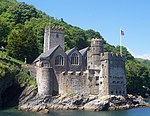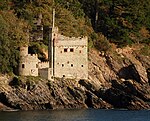Dartmouth Castle is an artillery fort, built to protect Dartmouth harbour in Devon, England. The earliest parts of the castle date from the 1380s, when, in response to the threat of a French attack, the civic authorities created a small enclosure castle overlooking the mouth of the Dart estuary. This was intended to engage enemy ships with catapults and possibly early cannon, and incorporated the local chapel of Saint Petroc within its walls. At the end of the 15th century, the castle was expanded with an artillery tower and an iron chain which could be stretched across the harbour to a tower at Godmerock; this addition formed the oldest known purpose-built coast artillery fort in Britain. Further gun batteries were added during the French invasion scare of the 1540s.
The castle saw service during the English Civil War of 1642 to 1646, during which its vulnerability to attack from the land became apparent, resulting in the Gallants Bower defensive work above it being used to provide additional protection. In 1748, a new gun position called the Grand Battery was added to the castle, equipped with twelve guns. After years of neglect in the early 19th century, the castle was upgraded in 1859 with modern artillery, but defending the port of Dartmouth was no longer a military priority. By the early years of the 20th century the castle was considered redundant by the authorities, who opened it to visitors. It was brought back into use during the Second World War, but in 1955 it was finally retired from service. In the 21st century, it is managed by English Heritage and the castle received 37,940 visitors in 2007.











